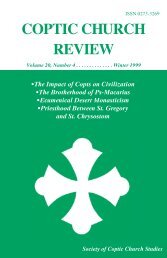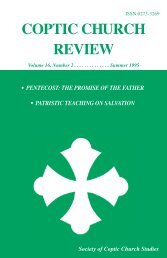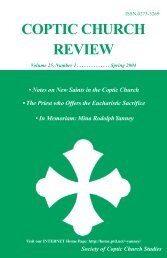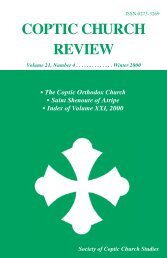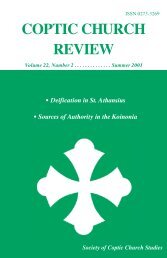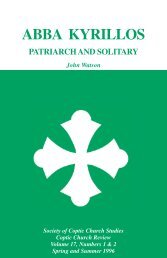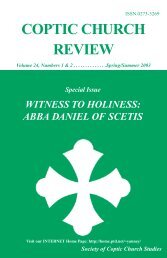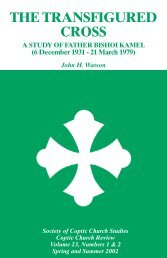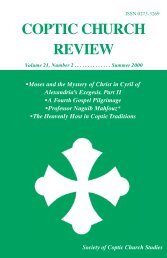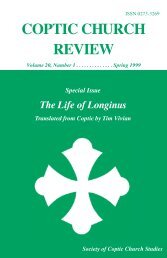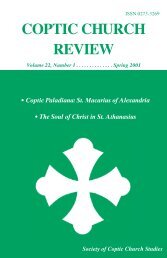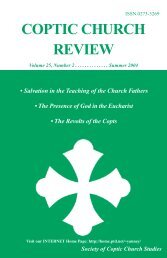Home_files/2000 Fall.Vol22.#3.pdf - Coptic Church Review
Home_files/2000 Fall.Vol22.#3.pdf - Coptic Church Review
Home_files/2000 Fall.Vol22.#3.pdf - Coptic Church Review
- No tags were found...
You also want an ePaper? Increase the reach of your titles
YUMPU automatically turns print PDFs into web optimized ePapers that Google loves.
COPTIC PALLADIANA III: THE LIFE OF MACARIUS OF EGYPT 89ed Christian groups of the third century, but increasingly out of place in thedeveloping imperial <strong>Church</strong> of the fourth. Certainly the social practices ofHieracas and his followers did not cohere with the institutional, episcopallycentered Christianity that Athanasius was forming.” It is striking that theanti-heresiological concerns of the author of the <strong>Coptic</strong> Life of Macariusare with Hieracas’ theology and not with his ascetical teachings and theresulting social practices which so vexed Athanasius. Presumably thesepractices would have also challenged Macarius and his followers; perhapsthis unnamed follower of Hieracas was a lone figure and the Hieracite communitieshad now vanished and thus were no longer a threat.As the account of the disciple of Hieracas shows, the Life is of morethan passing interest, both in its parts and as a whole; in conclusion, therefore,it is worth quoting in full M. Chaîne’s appreciation of it:One must recognize that the talent of the redactor, in thesepassages, is not slight, his information is not of the usualkind, and his account contains everything one would wishfrom an historian. Called on to reveal facts that smack ofthe marvelous, he works hard to specify the sources he hasdrawn on, as he does to be exact about the dates of theevents he is narrating, according to the needs of the narration.Thus he informs us, at the beginning, that it was thesecond year after the death of Macarius of Egypt that hearrived at the Mountain, two years before the death ofMacarius of Alexandria. He also questioned the very disciplesof the great monk, and he sought information in particularfrom one of them whose name he gives us:Evagrius. And gradually, as he tells his story, he takes careto distinguish what he has seen from what he has heardtold. He always seems to have present in his mind what hewrote at the outset, alluding to his veracity. Laying stresson precise documentation, full of details, the story in ourtext, said to be exaggerated, appears nevertheless in amore lively form, with a more revealing personality, thanthat which we have in the brief account. Our author, moreoften than the latter, puts himself in the action. More oftenhe addresses the reader, whom he connects to his narration,either by challenging him in the course of his accountor by making him participate in what he narrates. He letsthe persons he treats live and move; he lets them speak.He is fond of a direct style in preference to a simple tellingof their words or feelings. He puts himself in the action upto seven times. Overall he maintains a tone that disparages




